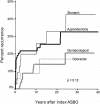Long-term prognosis after operation for adhesive small bowel obstruction
- PMID: 15273540
- PMCID: PMC1356393
- DOI: 10.1097/01.sla.0000132988.50122.de
Long-term prognosis after operation for adhesive small bowel obstruction
Abstract
Aim of study: The objective of this study was to determine the pattern of recurrence after one or more episodes of adhesive small bowel obstruction (ASBO) during a follow-up period of up to 40 years. Furthermore, we wanted to analyze possible factors with an influence on the recurrence rate and to study the magnitude of "everyday" abdominal pain among these patients.
Patients and methods: Hospital records of 500 patients operated on for adhesive obstruction at Haukeland University Hospital from 1961 to 1995 were studied. The patients were followed until death, loss to follow-up, or end of study (February 2002), with a median follow-up of 10 years and a maximum follow-up time of 40 years. A questionnaire was sent to all living patients to obtain information on recurrences and abdominal complaints.
Results: The cumulative recurrence rate for patients operated once for ASBO was 18% after 10 years and 29% at 30 years. For patients admitted several times for ASBO, the relative risk of recurrent ASBO increased with increasing number of prior ASBO episodes. The cumulative recurrence rate reached 81% for patients with 4 or more ASBO admissions. Other factors influencing the recurrence rate were the method of treatment of the last previous ASBO episode (conservative versus surgical) and the number of abdominal operations prior to the initial ASBO operation. Compared to results from the general populations, more ASBO patients suffer from abdominal pain at home. Women and patients having matted adhesions have significantly more complaints about abdominal pain than men and patients with band adhesions.
Conclusion: The risk of recurrence increased with increasing number of ASBO episodes. Most recurrent ASBO episodes occur within 5 years after the previous one, but a considerable risk is still present 10 to 20 years after an ASBO episode. Surgical treatment decreased the risk of future admissions for ASBO, but the risk of new surgically treated ASBO episodes was the same regardless of the method of treatment. People treated for ASBO seem to be more prone to experiencing abdominal pain than the normal population, especially those having matted adhesions.
Figures




Comment in
-
Intra-abdominal adhesion prevention: are we getting any closer?Ann Surg. 2004 Aug;240(2):202-4. doi: 10.1097/01.sla.0000133118.38686.d0. Ann Surg. 2004. PMID: 15273541 Free PMC article. No abstract available.
References
-
- Mucha P Jr. Small intestinal obstruction. Surg Clin North Am. 1987;67:597–620. - PubMed
-
- Ellis H. The causes and prevention of intestinal adhesions. Br J Surg. 1982;69:241–243. - PubMed
-
- Ræf LE. Causes of abdominal adhesions in cases of intestinal obstruction. Acta Chir Scand. 1969;135:73–76. - PubMed
-
- Miller G, Boman J, Shrier I, et al. Natural history of patients with adhesive small bowel obstruction. Br J Surg. 2000;87:1240–1247. - PubMed
-
- Akgur FM, Tanyel FC, Buyukpamukcu N, et al. Adhesive small bowel obstruction in children: the place and predictors of success for conservative treatment. J Pediatr Surg. 1991;26:37–41. - PubMed
Publication types
MeSH terms
LinkOut - more resources
Full Text Sources
Medical
Research Materials

